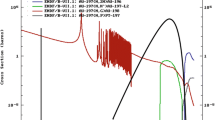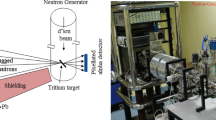Abstract
An inelastic neutron scattering system was developed to determine the elemental composition of large metallic materials. The geometrical size of the system was optimized by using Monte Carlo simulation. An experimental setup consisted of a DT neutron generator and a HPGe detector was built based on the optimized configuration and applied to analyze titanium samples. The net peak areas of titanium versus sample mass showed a linear dependence and the mass detection limit was 64 g. The prompt gamma spectra were compared to simulation data. The results demonstrated a good agreement for the signal-to-background ratio of titanium peak between measurements and simulations.








Similar content being viewed by others
References
Semenova IP, Polyakova VV, Dyakonov GS, Polyakov AV (2020) Ultrafine-grained titanium-based alloys: structure and service properties for engineering applications. Adv Eng Mater 22:1–13. https://doi.org/10.1002/adem.201900651
Kleedtke N, Hua M, Pozzi S (2021) A genetic algorithm optimization of tin–copper graded shielding for improved plutonium safeguards measurements. Nucl Inst Methods Phys Res A 988:164877. https://doi.org/10.1016/j.nima.2020.164877
Kurzynowski T, Pawlak A, Smolina I (2020) The potential of SLM technology for processing magnesium alloys in aerospace industry. Arch Civ Mech Eng 20:1–13. https://doi.org/10.1007/s43452-020-00033-1
Tapia G, Elwany A (2014) A review on process monitoring and control in metal-based additive manufacturing. J Manuf Sci Eng Trans ASME 136:1–10. https://doi.org/10.1115/1.4028540
Lednev VN, Sdvizhenskii PA, Asyutin RD et al (2019) In situ multi-elemental analysis by laser induced breakdown spectroscopy in additive manufacturing. Addit Manuf 25:64–70. https://doi.org/10.1016/j.addma.2018.10.043
Garmay AV, Oskolok KV, Monogarova OV (2020) Improved accuracy of multicomponent samples analysis by x-ray fluorescence using relative intensities and scattered radiation: a review. Anal Lett 53:2685–2699. https://doi.org/10.1080/00032719.2020.1751651
Wu J, Qiu Y, Li X et al (2020) Progress of laser-induced breakdown spectroscopy in nuclear industry applications. J Phys D Appl Phys. https://doi.org/10.1088/1361-6463/ab477a
Tamilarasu S, Velraj G, Ray DK, Acharya R (2016) Chemical analysis of archaeological clay potteries by PIGE and PIXE methods using proton beams from tandem accelerator for provenance study. J Radioanal Nucl Chem 310:363–370. https://doi.org/10.1007/s10967-016-4842-1
Sari A, Garti S, Lainé F et al (2020) Detection and quantification of copper in scrap metal by linac-based neutron activation analysis. Appl Radiat Isot 166:109339. https://doi.org/10.1016/j.apradiso.2020.109339
Kasztovszky Z, Révay Z, Belgya T et al (2000) Nondestructive analysis of metals by PGAA at the Budapest Research Reactor. J Radioanal Nucl Chem 244:379–382. https://doi.org/10.1023/A:1006791710995
Révay Z (2009) Determining elemental composition using prompt γ activation analysis. Anal Chem 81:6851–6859. https://doi.org/10.1021/ac9011705
Nair AGC, Sudarshan K, Raje N et al (2004) Analysis of alloys by prompt gamma-ray neutron activation. Nucl Instruments Methods Phys Res Sect A Accel Spectrometers, Detect Assoc Equip 516:143–148. https://doi.org/10.1016/j.nima.2003.07.044
Tian KV, Festa G, Szentmiklósi L et al (2017) Compositional studies of functional orthodontic archwires using prompt-gamma activation analysis at a pulsed neutron source. J Anal At Spectrom 32:1420–1427. https://doi.org/10.1039/c7ja00065k
Arcidiacono L, Martinón-Torres M, Senesi R et al (2020) Cu-based alloys as a benchmark for T-PGAA quantitative analysis at spallation neutron sources. J Anal At Spectrom 35:331–340. https://doi.org/10.1039/c9ja00268e
Maróti B, Kis Z, Szentmiklósi L et al (2017) Characterization of a South-Levantine bronze sculpture using position-sensitive prompt gamma activation analysis and neutron imaging. J Radioanal Nucl Chem 312:367–375. https://doi.org/10.1007/s10967-017-5219-9
Sudarshan K, Tripathi R, Nair AGC et al (2005) A simple method for correcting the neutron self-shielding effect of matrix and improving the analytical response in prompt gamma-ray neutron activation analysis. Anal Chim Acta 549:205–211. https://doi.org/10.1016/j.aca.2005.06.021
Randriamalala TH, Rossbach M, Mauerhofer E et al (2016) FaNGaS: a new instrument for (n, n′γ) reaction measurements at FRM II. Nucl Instruments Methods Phys Res Sect A Accel Spectrometers, Detect Assoc Equip 806:370–377. https://doi.org/10.1016/j.nima.2015.10.026
Naqvi AA, Khiari FZ, Al-Abdallah T et al (2019) Detection of sulfur in soil samples using 2.5 MeV neutron activation. J Radioanal Nucl Chem 321:355–360. https://doi.org/10.1007/s10967-019-06589-4
Yakubova G, Kavetskiy A, Prior SA, Allen Torbert H (2019) Application of neutron-gamma analysis for determining compost C/N ratio. Compost Sci Util 27:146–160. https://doi.org/10.1080/1065657X.2019.1630339
Abel MR, Nie LH (2019) Improving the sensitivity of fast neutron inelastic scatter analysis to iron using associated particle collimation. Nucl Instruments Methods Phys Res Sect A Accel Spectrometers, Detect Assoc Equip 932:31–42. https://doi.org/10.1016/j.nima.2019.04.054
Mauerhofer E, Havenith A (2014) The MEDINA facility for the assay of the chemotoxic inventory of radioactive waste packages. J Radioanal Nucl Chem 302:483–488. https://doi.org/10.1007/s10967-014-3210-2
Arce P, Ignacio Lagares J, Harkness L et al (2014) Gamos: a framework to do Geant4 simulations in different physics fields with an user-friendly interface. Nucl Instruments Methods Phys Res Sect A Accel Spectrometers, Detect Assoc Equip 735:304–313. https://doi.org/10.1016/j.nima.2013.09.036
Hei D, Jia W, Cheng C et al (2021) Feasibility study of fast neutron-induced gamma ray imaging of large sample based on D-T neutron generator. Nucl Inst Methods Phys Res B 492:7–14. https://doi.org/10.1016/j.nimb.2021.01.014
Yamauchi A, Iwasaki M, Hayashi K, Tsuji K (2019) Evaluation of full-field energy dispersive X-ray fluorescence imaging apparatus and super resolution analysis with compressed sensing technique. X-Ray Spectrom 48:644–650. https://doi.org/10.1002/xrs.3055
Ilic Z, Mauerhofer E, Stieghorst C et al (2020) Prompt gamma rays induced by inelastic scattering of fission neutrons on iron. J Radioanal Nucl Chem. https://doi.org/10.1007/s10967-020-07271-w
Olacel A, Belloni F, Borcea C et al (2017) Neutron inelastic scattering measurements on the stable isotopes of titanium. Phys Rev C 96:1–12. https://doi.org/10.1103/PhysRevC.96.014621
Mildenberger F, Mauerhofer E (2017) Cyclic neutron activation analysis of large samples with a pulsed 14 MeV neutron source. J Radioanal Nucl Chem 311:917–927. https://doi.org/10.1007/s10967-016-5098-5
Szentmiklósi L (2018) Fitting special peak shapes of prompt gamma spectra. J Radioanal Nucl Chem 315:663–670. https://doi.org/10.1007/s10967-017-5589-z
Cheng C, Wei Z, Hei D et al (2020) MCNP benchmark of a 252Cf source-based PGNAA system for bulk sample analysis. Appl Radiat Isot 158:109045. https://doi.org/10.1016/j.apradiso.2020.109045
Yakubova G, Kavetskiy A, Prior SA, Torbert HA (2017) Applying Monte-Carlo simulations to optimize an inelastic neutron scattering system for soil carbon analysis. Appl Radiat Isot 128:237–248. https://doi.org/10.1016/j.apradiso.2017.07.003
Acknowledgements
This work was supported by National Natural Science Foundation of China (11775113 and 11975121).
Author information
Authors and Affiliations
Corresponding author
Additional information
Publisher's Note
Springer Nature remains neutral with regard to jurisdictional claims in published maps and institutional affiliations.
Rights and permissions
About this article
Cite this article
Hei, D., Jia, W., Cheng, C. et al. Design of an inelastic neutron scattering system based on DT neutron generator for metallic materials analysis. J Radioanal Nucl Chem 329, 301–308 (2021). https://doi.org/10.1007/s10967-021-07755-3
Received:
Accepted:
Published:
Issue Date:
DOI: https://doi.org/10.1007/s10967-021-07755-3




